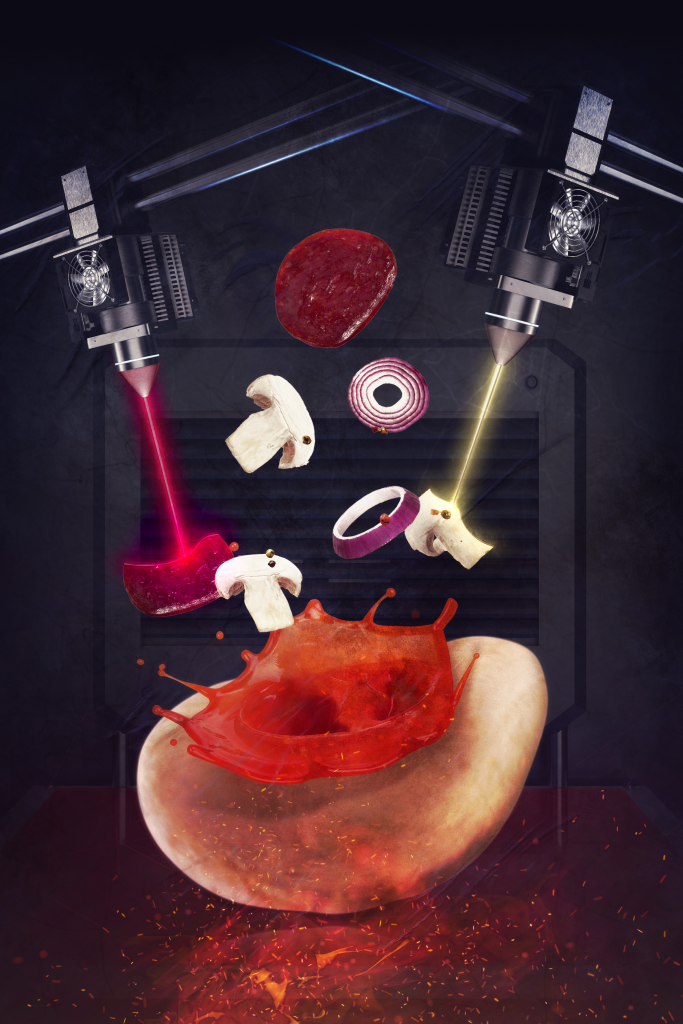The Moths are in the Pesto
Friday night in the Brown household means two things: Pizza Fridays and watching the latest episode of Neurochef together. After a week of only sipping on specialised meal replacement drinks, everyone’s excited to chew on something different. Mom Lisa and teenage daughter Cassie are prepping the food in the kitchen with their fancy new Pizza Popper machine, which 3D prints and cooks perfect garlic flavoured pizza bases in two minutes, then proceeds to print each family member’s order for toppings. Ten-year-old Bruno loves spicy green spelt meatballs, fried yam and mozzarella, while dad Fariq sticks with his old double-meat favourite of fungi pepperoni, mealworm mince and pickled cactus. Cassie is trialing a new jellyfish-only intermittent fasting diet, so she’s prepping her pad thai style noodles on the side.
There’s huge excitement in the air for the semi-final of the world’s favourite cooking show. Three teams will have a final cook-off for a place in the final, judged by top neurogastronomists. On the team: a talented chef, scent DJ, body music composer, plate curator and senseuse (sensory stylist). Neurochef is based on the pillars of neurogastronomy – the science of how our brains ‘taste’ food through our senses of sight, smell, touch, taste and sound.

Contestants are required to prepare a showstopper three-course meal with unique challenges. No seasoning is allowed so they’ll have to conceptualise special sounds and aromas to trick judges into smelling and tasting mouthwatering creations. If one team draws the red card, they get to sabotage an opponent’s creation by restyling their plates. The Brown family is on the edge of their seats to see if their favourite team’s food gets the dreaded red plate (known for switching someone off their food). The senseuse will have only sixty minutes to come up with a virtual reality experience to immerse judges (and everyone at home) in a cozy or exotic environment that compliments the chosen cuisine, while telling a story. It’s food theatre deluxe.
The winners will each walk away with an electric self-driving car and a year’s contract with personalised nutrition giant, Tummible, to work with AI recipe writers on fresh new food plans. Pizzas in hand, the Browns are glued to the screen to see what happens next…
Personalised nutrition with an exotic twist
By 2051, food will be far more of a fuel than a fixation (although, for some, still very much a TV obsession). By then, we will be so sophisticated in how we bio-hack our bodies that we may not eat much at all. With connected health devices tracking our every step, breath and heartbeat, we’ll be relying on delicious custom-mixed meal replacement drinks and powders to turn our bodies into high-performance machines. Those who live in first-world countries will be government-issued with free fitness trackers to incentivise healthier living. Those who can afford it will subscribe to precision food prescriptions, fine-tuned through microbiome mapping.
Engineered with a dizzying array of proteins, vitamins and minerals, essential omega fatty acids and fibre, you’ll get exactly what your body needs every time – nothing more, nothing less. A combination of glucose implants and metabolic breath sensors will tell you exactly how your body is functioning in real-time. Conditions like obesity, diabetes and high cholesterol will become a thing of the past.
If you do decide to eat food, personalised nutrition will guide your every choice. You’ll know exactly which foods will cause cravings and how each bite influences your metabolism. Everyone will be on the metabo-friendly bandwagon, from personal appliances to grocery stores, restaurants and fast-food outlets. Your app will sync with your smart fridge to recommend and order food based on your personalised diet plan. On supermarket shelves, where you once only had options like low vs. full fat or salt vs. no salt, foods will be available in lots of variants customised to common metabolism types (e.g. high fat, high protein, medium fibre).
Speaking of grocery stores – where have the meat and fish aisles gone? They are still there, just not how you remember them. Gone are the days of your fishmonger filleting your trout in-store or a butcher cutting your rib-eye steak to size. You can still pick your perfect meat cut but it will be shaped like a lamb chop and lab-grown from animal stem-cells. Or your fish fillets will be grown from fungi combined with algae and plant-based ingredients. Each fresh product will also come in metabolic-friendly varieties that include just the right ratio of fat, protein, minerals and vitamins you’ll find in the real deal. You could probably still get hold of meat or fish from niche suppliers but it will be somewhat frowned upon – like smoking or eating foie gras – not quite illegal but certainly not mainstream.
Next to the ‘fish’ and ‘meat’ counters, you’ll pore over the week’s selection of edible insects to include in your Bolognese sauce or rich chocolate cake. These will be sold unprocessed (wings and legs on) for snacking and cooking, or available in a large variety of familiar shapes, from fruit loop cereal and couscous to burgers and sausages. If creepy crawlies don’t tickle your tastebuds, you’ll feel like a hero for shopping in the ‘harm-to-table’ section: where invasive species like crayfish, crab and jellyfish help foodies-in-the-know dish up a greener meal.
Remember all those aisles filled with carb-rich things like pasta, rice and flour? These will now be largely protein-based offerings, with everything from cookies to crackers enriched with protein from sources like desert-grown seaweed and fruit flies. You’ll probably have a hard time finding the basmati rice or durum wheat pasta amongst the packs of cowpeas, finger millet and amaranth, and bags of Bambara, Marama and Adzuki beans.
Smarter eating means healthier bodies and earth
Chargrilled burgers with melting cheese, creamy fish chowder, ravioli with melt-in-the-mouth fillings. In 2051, all your favourites will still exist – albeit in completely different formats. As you tuck into your lab-grown chicken burger on a protein-rich fonio flour bun, you’ll listen to a special neurogastronomical soundtrack to make you feel satiated faster (no deep bass hip-hop for you). Your ravioli will be filled with smoked carrot salmon, chopped caterpillar and sharp fungi cheese, while your tofish chowder will be thickened with insect milk, and swimming with delicious invasive crab legs. You’ll sip this with a textured spoon – proven by neurogastronomists to make foods taste saltier without any added sodium. Portions will be tiny as you’ll have conditioned yourself over the years to eat less and less. If you’re still hungry, you’ll finish your meal with a dandelion root and tiger nut milk latte, then immediately start tracking in real-time how this food is metabolised.
Our palates will become more adventurous as food scarcity compels us to try different things. We may not know what teff, ube, rabi or enoki are right now but in 2051, these future foods will be very much part of our day-to-day cuisines. Why? Well, firstly, we’ve been eating far too boringly for far too long. Did you know that 75% of the global food supply comes from only 12 plant and 5 animal species? And that 3 types of plants (rice, maize, wheat) make up nearly 60% of calories in the entire human diet? This is not just narrow-minded eating, it’s also missing out on many valuable sources of vitamins and minerals. However, we won’t be eating strange things for novelty’s sake. Our collective conscience will catch up with us because we can’t continue destroying the earth for what is essentially a luxury diet. How can we keep munching away at chicken and beef if 80% of the world’s agricultural land is used for animal farming, which produces just 20% of the world’s calories? What’s more, the world simply can’t sustain food production for the 10 billion people expected to be living on earth by 2050 unless farming and food industries become much more sustainable.
One way we’re already doing this is by going meat-free, and continuing to investing in new meat and fish alternatives. The hottest topic of all? Entomophagy – the custom of eating insects. Snacking on bees, bugs, moths and worms is nothing strange in places like Thailand, China, Brazil, Mexico and parts of Africa. With more than 2000 species of edible insects in the world, there is much to explore. Crickets, grasshoppers and mealworms are particularly popular for being high in protein. Salted butter mealworm snacks, anyone? Fig, chocolate and buffalo worm powder protein bars? French manufacturer Jimini has been on a mission to normalise insect eating since 2012. Eat Grub, the forward-thinking UK insect-eating evangelist, is one of many to have brought out a cookery book and offers a range of freeze-dried, ready-to cook insects, cricket powder energy bars and roasted grub snacks.
EntoMilk, a dairy alternative made in South Africa by blending the larvae of the black soldier fly, is used for luxury ice cream. Micronutris was one of the first French companies to farm insects. Today, they sell a wild array of insects to use in cooking, with delicious recipe ideas to match like pumpkin soup with hazelnuts and crickets, or ravioli with mealworms and chestnuts. In Switzerland, Essento’s insect burgers and meatballs have been on sale in Coop, one of the country’s largest supermarket chains, since 2017.
Another non-meat option on the rise is lab-grown meat, with companies like Meatable and Ivyfarm leading the way in making slaughter-free meat. Just like taking a cutting from a plant, Meatable takes a sample of cells from an organically raised animal and nurtures it in a large tank called a bioreactor. In under three weeks, these cells multiply to around 1kg of meat. Ivyfarm will take its first product (pork sausages) to market by as early as 2023, with Angus beef burgers and Wagyu meatballs to follow. This production method has the potential to use 96% less water and 99% less land than industrial farming. Somewhat less extreme will be the next generation of vegan ‘Beyond Meat’ plant-based meat. Like your meat on the rare side? Nothing is off-limits for these entrepreneurs – Impossible Meat even has a burger patty that ‘bleeds’ just like meat. We’ll continue to experiment with meat-like plants, such as jackfruit for pulled pork and banana flower for fish, to slowly wean ourselves off meat-eating.
Now imagine you can take all these interesting new superfoods, grind them down and ingest them all at once? Imagine you can find the perfect fuel for your unique body – for example, the exact potion for your IBS, your weight loss and your gluten intolerance. The next generation of meal replacements is already doing just that. Mana’s ‘subatomically perfect’ complete meal solutions contain 42 essential nutrients, with protein and fibre from soy, peas, oats, hemp, rice, and algae. The list of these ‘Silicon Valley’ drinks goes on, from Soylent and Huel to Yfood, OWYN and Saturo. Every one of them shares the same idea – that food can be simplified for the better. For too long, we have optimised food for taste instead of for its primary purpose of providing all the nutrition your body needs. These drinks and bars bring precision and efficiency to how we feed ourselves. Dutch brand Queal goes a step further, with a dashboard to track the impact Queal use has on your health, wealth, and environmental footprint. Adding a gamification element, you can also compare results with friends, earn points and level up.
It’s a given that personal nutrition, wearables and connected devices will rule culinary choices in thirty years’ time. Apps and algorithms will identify what we should eat or avoid, and will know exactly what we keep in our smart fridges or order in our online shopping carts. Metabolic health doesn’t just influence your weight; it’s also responsible for how well your body processes food (i.e. gut health), your energy levels and how well you sleep. No two people are the same when it comes to metabolism. Two people of the same age and health vitals can eat the exact same diet, but have vastly different body shapes and health conditions. This is something that Israel’s Weizmann Institute of Science has been studying for years. One of its initiatives, Project 10K, is collecting personal health data from thousands of Israeli residents, which will be processed using sophisticated artificial intelligence tools to identify a person’s likelihood of disease. They are already using algorithms to diagnose Covid from lung images, predict the risk of gestational diabetes or determine someone’s risk of developing an acute form of leukemia.
Some of the startups already offering bespoke nutritional advice by algorithm include Veri, DayTwo, Thryve, Nutrino and Zoe. Simply send in some blood and stool samples, wear a continuous glucose monitor device, and do some home tests and questionnaires. A few weeks later, you’ll receive a detailed report comparing your results to those of thousands of other people. If you want to go a step further, invest in a breath analyser like Lumen – the world’s first portable device to accurately measure metabolism. In just one breath, Lumen will measure the CO2 in your breath, which indicates the type of fuel your body is using to produce energy. With Lumen’s daily insights, you will improve your metabolism by improving your body’s ability to shift efficiently between using fats or carbs as a source of energy.
Probability
Thirty years from now, the word flexitarian will take on a whole new meaning. Will we flex eat between meal replacements and real food eating? Or between plant-based and lab-grown? Will you be vegan with a side of insects? Will your pescatarian diet mostly consist of jellyfish, farmed fish and algae products? There will definitely be terms for our new metabolism and earth-friendly way of eating.
Our bodies are fascinating things – rich with data waiting to be mined by everyone, from eager start-ups to tech giants, like Amazon and Apple. Our tongues might ‘tell’ our brains we’re tasting one of five things, but taste is very much influenced by how we see, hear, smell and feel our food. And then there is how flavour is perceived by our gustatory cortex (the perceptual taste centre of your brain). Studies from Columbia University have already proved it possible to activate the bitter-responsive neurons of a mouse’s brain, so that it disliked the sweet water it was given. In which case, it could be entirely possible to trick human brains to like lettuce over donuts in thirty years’ time, right?
Hippocrates predicted over 2000 years ago that food should be our medicine. While this still rings true, let’s hope that it will continue to be our way to celebrate togetherness and nourish ourselves, not the intense and somewhat unhinged obsession we have with it right now.
Listen to our podcast
English version
French version
References
- Armstrong, S. (2018, March 22). To feed two billion more people, the world needs a bug diet. Wired. https://www.wired.co.uk/article/eating-insects-bugs-food-exo-entocycle-flyingspark-essento-eat-grub
- Entomilk | Gourmet Grubb. (n.d.). Entomilk. https://gourmetgrubb.com/entomilk/
- Floreak, M. (2019, June 25). From Menace to Moeche. Edible Boston. https://www.edibleboston.com/blog/2019/6/25/from-menace-to-moeche
- Future of food report. (2019). https://www.about.sainsburys.co.uk/~/media/Files/S/Sainsburys/pdf-downloads/futureoffood-10c.pdf
- Hack your metabolism | Lumen. (n.d.). Lumen. https://www.lumen.me
- Insectes Comestibles. (n.d.). Les insectes, source de protéines, meilleurs que la viande – InsectesComestibles.fr. https://www.insectescomestibles.fr/content/21-les-insectes-source-de-proteines-meilleurs-que-la-viande
- Knorr x WWF. (2019, February). 50 foods for healthier people and a healthier planet. https://www.wwf.org.uk/sites/default/files/2019-02/Knorr_Future_50_Report_FINAL_Online.pdf
- La consommation d’insectes, une alternative alimentaire aux vrais atouts environnementaux. (2020, October 15). 20 minutes. https://www.20minutes.fr/planete/2884023-20201015-consommation-insectes-alternative-alimentaire-vrais-atouts-environnementaux
- Levels – Metabolic Fitness Program. (n.d.). Levels. https://www.levelshealth.com
- ManaTM | Food for a better life. (n.d.). ManaTM | Europe. https://drink-mana.com
- Micronutris : Les insectes comestibles de qualité biologique. (n.d.). Micronutris. https://www.micronutris.com/fr/accueil
- Owyn® – vegan Plant-Based protein shakes & powders. (n.d.). Owyn. https://liveowyn.com
- Product Overview | Queal Shop. (n.d.). Queal. https://queal.com/shop/overview/
- PROJECT 10K. (n.d.). PROJECT 10K. https://www.project10k.org.il/en#what-project-10k
- Saturo – Die vollwertige Komplettnahrung. (n.d.). Saturo. https://saturo.com
- Smith, N. (2020, November 17). Monitor your metabolic health with these Apple Health compatible platforms. MyHealthyApple. https://www.myhealthyapple.com/monitor-your-metabolic-health-with-these-leading-platforms-apple-health/
- Soylent.com – Let us take a few things off your plate. (n.d.). Soylent. https://soylent.com/
- Vegan Burger Meat, Crumbles, & Sausages | Beyond Meat. (n.d.). Beyond Meat. https://www.beyondmeat.com
- Veri – Your metabolic compass. (n.d.). Veristable. https://www.veri.co/
- Wikipedia contributors. (2021, November 24). Spirulina (dietary supplement). Wikipedia. https://en.wikipedia.org/wiki/Spirulina_(dietary_supplement)
- yfood – Manger sainement. En toute occasion. (n.d.). yfood FR. https://fr.yfood.eu




